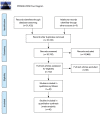Time-dependence and comparison of regional and overall anthropometric features between Asian and Caucasian populations with obstructive sleep apnea: a cumulative meta-analysis
- PMID: 33841965
- PMCID: PMC8024799
- DOI: 10.21037/jtd-20-1799
Time-dependence and comparison of regional and overall anthropometric features between Asian and Caucasian populations with obstructive sleep apnea: a cumulative meta-analysis
Abstract
Background: Anthropometric measurements are simple and reachable tools for self-evaluating and screening patients with a high risk of obstructive sleep apnea (OSA). However, the accumulated relationship of obesity on the anthropometric characteristics of OSA is not well understood. The aim of the study was to show the time-dependent trend of OSA patients and compare overall and regional anthropometric between two ethnicities.
Methods: A cumulative meta-analysis was performed to assess obesity metrics in patients with and without OSA between Asians and Caucasians. We searched PubMed, Web of Science, Embase, and Scopus up to Jun 2020. Included studies used body mass index (BMI), neck circumference (NC), waist circumference (WC) and waist-to-hip ratio (WHR) as measures of anthropometric features in the adult OSA population and controls, utilized in-lab polysomnography or home sleep testing with apnea-hypopnea index (AHI) or respiratory disturbance index (RDI) classification, reported ethnicity/race, and were published in English. Any studies lacking one of these criteria or sufficient data were excluded.
Results: Forty studies with a total of 19,142 subjects were investigated. Comparison of changes between patients with and without OSA showed that OSA patients had a higher BMI [mean difference (MD) 3.12, 95% confidence interval (CI): 2.51-3.73], NC (MD 3.10, 95% CI: 2.70-3.51), WC (MD 9.84, 95% CI: 8.42-11.26) and waist-hip ratio (MD 0.04, 95% CI: 0.03-0.05) than the control subjects. The accumulated time-dependent increase in population with OSA was significantly apparent with all anthropometric features. BMI increased from 2000 (MD 0.50) to 2012 (MD 3.08-3.48) and remained stable afterwards (MD 2.70-3.17), NC increased from 2000 (MD 0.40) to 2013 (MD 3.09) and remained stable afterwards too (MD 3.06-3.21). WC increased from 2000 (MD 2.00) to 2012 (MD 9.37-10.03) and also remained stable afterwards (MD 8.99-9.84). WHR was stable from 2000 to 2004 with an MD of 0.01 and then stable from 2007 onwards with an increased MD of 0.03-0.04. Compared with Caucasian patients, Asian patients had lower obesity relevant variates.
Conclusions: BMI, NC, WC and WHR are associated with OSA in both ethnic groups. Anthropometry for overall and regional obesity could facilitate differentiation of patients with OSA from individuals without OSA by ethnicity.
Keywords: Obstructive sleep apnea (OSA); anthropometric parameters; cumulative meta-analysis; ethnicity; obesity.
2021 Journal of Thoracic Disease. All rights reserved.
Conflict of interest statement
Conflicts of Interest: All authors have completed the ICMJE uniform disclosure form (available at http://dx.doi.org/10.21037/jtd-20-1799). The authors have no conflicts of interest to declare.
Figures







Similar articles
-
Comparison of Anthropometric Data Between Asian and Caucasian Patients With Obstructive Sleep Apnea: A Meta-Analysis.Clin Exp Otorhinolaryngol. 2016 Mar;9(1):1-7. doi: 10.21053/ceo.2016.9.1.1. Epub 2016 Mar 7. Clin Exp Otorhinolaryngol. 2016. PMID: 26976019 Free PMC article. Review.
-
Sex-specific characteristics of anthropometry in patients with obstructive sleep apnea: neck circumference and waist-hip ratio.Ann Otol Rhinol Laryngol. 2014 Jul;123(7):517-23. doi: 10.1177/0003489414526134. Ann Otol Rhinol Laryngol. 2014. PMID: 24668052
-
Anthropometric Indices of Obstructive Sleep Apnea Patients in Mauritius.Cureus. 2024 Oct 30;16(10):e72708. doi: 10.7759/cureus.72708. eCollection 2024 Oct. Cureus. 2024. PMID: 39483600 Free PMC article.
-
Anthropometrical phenotypes are important when explaining obstructive sleep apnea in female bariatric cohorts.J Sleep Res. 2019 Oct;28(5):e12830. doi: 10.1111/jsr.12830. Epub 2019 Feb 11. J Sleep Res. 2019. PMID: 30740836
-
Anti-inflammatory medications for obstructive sleep apnoea in children.Cochrane Database Syst Rev. 2020 Jan 17;1(1):CD007074. doi: 10.1002/14651858.CD007074.pub3. Cochrane Database Syst Rev. 2020. PMID: 31978261 Free PMC article.
Cited by
-
Level 2 Polysomnography for the Diagnosis of Sleep Disorders: A Health Technology Assessment.Ont Health Technol Assess Ser. 2024 Aug 20;24(7):1-157. eCollection 2024. Ont Health Technol Assess Ser. 2024. PMID: 39372311 Free PMC article.
-
Strengths and Limitations of BMI in the Diagnosis of Obesity: What is the Path Forward?Curr Obes Rep. 2024 Sep;13(3):584-595. doi: 10.1007/s13679-024-00580-1. Epub 2024 Jul 3. Curr Obes Rep. 2024. PMID: 38958869 Free PMC article. Review.
-
Unique clinical phenotypes of patients with obstructive sleep apnea in a Japanese population: a cluster analysis.J Clin Sleep Med. 2022 Mar 1;18(3):895-902. doi: 10.5664/jcsm.9752. J Clin Sleep Med. 2022. PMID: 34725035 Free PMC article.
-
Associations between abdominal obesity and the risk of stroke in Chinese older patients with obstructive sleep apnea: Is there an obesity paradox?Front Aging Neurosci. 2022 Sep 12;14:957396. doi: 10.3389/fnagi.2022.957396. eCollection 2022. Front Aging Neurosci. 2022. PMID: 36172486 Free PMC article.
-
Risk assessment and prevention of cardiovascular events in patients with obstructive sleep apnea syndrome: A narrative review.Int J Cardiol Cardiovasc Risk Prev. 2025 Jun 19;26:200455. doi: 10.1016/j.ijcrp.2025.200455. eCollection 2025 Sep. Int J Cardiol Cardiovasc Risk Prev. 2025. PMID: 40642225 Free PMC article. Review.
References
LinkOut - more resources
Full Text Sources
Other Literature Sources
Miscellaneous
